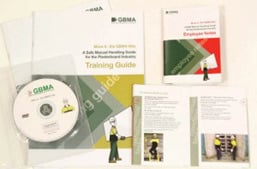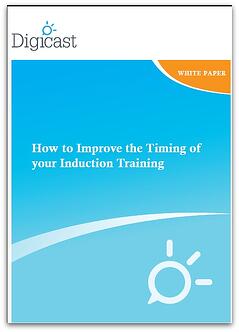"A lot of organisations use a lot of text to train people, but reading is inefficient for the brain, as it has to convert each letter into a picture to process," Ms Ross said.
"Educational researchers have found that 83 per cent of human learning occurs visually and our brain has much of its space dedicated to processing visual images."
Digicast has worked with a wide range of clients on a variety of training and safety communication programs, that include trainer’s workbooks and employee handbooks that centre around a highly engaging training video.
Posters are also created to also remind workers of what they have learnt on the job. Ms Ross said these videos don't replace traditional learning, but instead help supplement and enhance the learning experience for employees.
"We would never recommend that companies just get their staff to play a DVD and that's their training covered. Research has found that active safety training is three times more effective than passive safety training. This means you need to get people interacting with the information," Ms Ross said.
A 2004 study from the University of Lethbridge in Canada showed that interactive learning methods assist retention rate and memory - something Digicast has latched on to.
"An engaging safety training program will use training materials that include visuals and audio information. Rather than relying on heavy text-based manuals and PowerPoint slides, a good training program will have a trainer introducing video, Q&A afterwards, a short quiz and then getting trainees to try their new skills," Ms Ross said.
Aside from more effective learning, Ms Ross said Digicast's clients have found other benefits, including reduced training costs and time, corporate credibility and consistency.
"For clients who want to save on training costs, we've found they'll reduce their training duration by around 67 per cent. Another benefit is credibility. For example, if workers get tossed a manual to read, they'll think their company doesn't care enough about safety or training," Ms Ross said.
"For large companies, another important benefit is consistency. They find that through the use of multimedia, employees will do tasks consistently, since they're all trained the same way. This can really improve productivity and frustration from managers.
"It can even unite different sites to actually discuss how to do things properly, which enables companies that normally work in defined silos, to communicate more with one another."
Ross said incorporating video into organisational learning and training doesn't stop when the video ends. It is also important to provide a feedback loop and encourage staff to retain the information.
"Staff should continuously receive coaching and feedback. They have to do quizzes. Using these techniques makes training way more effective than getting people to read a manual, attend a presentation or do an online program," Ms Ross said.
"That’s why we also create trainer’s workbooks that include lots of activities to make the training more active. Employees can also get more involved by having their own workbook, with photos and diagrams, that they can refer to on the job."
Ms Ross said working out the challenges companies face and researching the best solution has been a core aspect of Digicast's success, which boasts clients such as CSR Viridian, Murray Goulburn, Incitec Pivot, CFA and Gypsum Board Manufacturer's of Australasia.
It’s also why she started The Workplace Communicator blog, that has weekly updates on training, workplace safety communication and video information for safety, communication, training professionals and executives.
"We've been making training videos for over 20 years, and while the music style and clothes from the early 1990s have changed, we've also changed how we produce a training video based on feedback from our clients and research studies," Ms Ross said.
"Rather than just do video, we’ve also introduced other communication services (such as workplace safety communication consulting and training) for companies who want to take their safety campaigns to the next level."
"We work with companies that really care about safety, training and their staff. They realise that written training manuals can be very off-putting and are not conducive to improving skill acquisition and knowledge."
 Digicast has launched an easy to use online induction software available for companies who wish to centralize their staff training at the one location and track the training status of employees and contractors. It’s ideal for organisations, who no longer want the hassle of manually tracking employee training status or compiling induction training materials for new recruits.
Digicast has launched an easy to use online induction software available for companies who wish to centralize their staff training at the one location and track the training status of employees and contractors. It’s ideal for organisations, who no longer want the hassle of manually tracking employee training status or compiling induction training materials for new recruits.
 A helpful new online resource centre has been launched for senior executives, safety, training, HR and communication professionals to easily find up-to-date information related to induction training, workplace safety communication and video production.
A helpful new online resource centre has been launched for senior executives, safety, training, HR and communication professionals to easily find up-to-date information related to induction training, workplace safety communication and video production. Until recently, organisational communication and training revolved around text materials and powerpoint presentations, but one company is the business to change this.
Until recently, organisational communication and training revolved around text materials and powerpoint presentations, but one company is the business to change this. It’s smart for companies to be worried about staff and customer training videos and how to tackle them correctly. There are so many choices. Quite frequently, training videos are produced that just don’t get watched. Now making the right decision has just got easier.
It’s smart for companies to be worried about staff and customer training videos and how to tackle them correctly. There are so many choices. Quite frequently, training videos are produced that just don’t get watched. Now making the right decision has just got easier. It’s smart for companies to be worried about staff training videos and how to tackle them correctly. There are so many choices. Quite frequently, training videos are produced that just don’t get used. Now, working out what components to include in your training video just got easier.
It’s smart for companies to be worried about staff training videos and how to tackle them correctly. There are so many choices. Quite frequently, training videos are produced that just don’t get used. Now, working out what components to include in your training video just got easier. 
 Time is precious. In most companies finding the time to train and allowing staff time for training is problematic. This new report provides key information on how to reduce induction training time and create flexible training that both improves training results, but also reduces training costs.
Time is precious. In most companies finding the time to train and allowing staff time for training is problematic. This new report provides key information on how to reduce induction training time and create flexible training that both improves training results, but also reduces training costs.
 Writing an engaging Safety Speech can be Tricky. This New Report reveals the Key Steps behind writing a convincing Workplace Safety Speech.
Writing an engaging Safety Speech can be Tricky. This New Report reveals the Key Steps behind writing a convincing Workplace Safety Speech. 